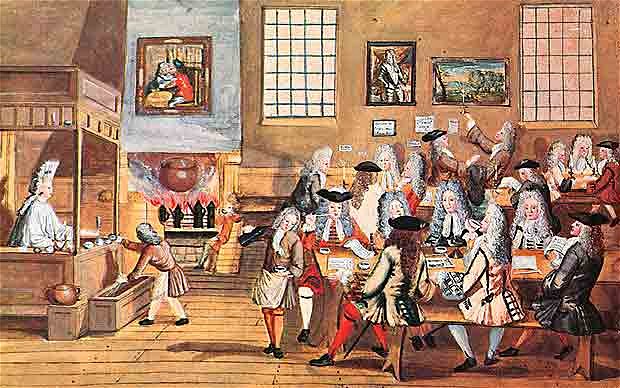From the Coffee House to Twitter

It's commonplace to say that the Internet, with its preference for small, digestible bits of information, is killing age-old, traditional longform journalism. Yet in a recent talk at Berkeley, Robert Darnton, the Carl H. Pforzheimer University Professor of History and director of the Harvard University Library, argued that news has long been made up of small tweet-like bits of information. He drew parallels between the gossip-fueled publishing world of yesteryear and today’s Internet, where blogs, Twitter and Facebook are high tech gossip delivery systems.
Blog posts, Darnton said, or, at least, little chunks of information that get passed around, aren’t a 20th Century phenomenon. While they operated in very different contexts, little blog-like “anecdotes,” have been around at least since around 550 AD, when Procopius authored the salacious Secret History of Emperor Justinian and his wife, Theodora. Darnton’s focus is on the 17th and 18th Centuries, a golden age of gossiping… er, blogging.
Trashy gossip, he said, isn’t just interesting because it’s scandalous: you can get a map of 17th and 18th Century information systems by following the circulation of rumors, like a doctor injecting dye into a patient’s vein. Back then, nothing travelled as fast or as widely as news about Louis the XV’s sex life.
Not that things are so different now. Professor Darnton showed Perez Hilton’s picture of the Governor of Nevada with a showgirl on each arm and a sexy picture of Carrie Prejean with the blaring headline, “CARRIE PREJEAN IS LIVING IN SIN!”
Of course, the “paragraph men” and “nouvellistes,” as they called themselves back then, weren’t retweeting all this juicy gossip from their smartphones. They were getting the dirt by hanging out in London coffee houses and Paris cafés, and even under a special tree in the Luxembourg Gardens. These proto-newsmen would run their tidbits to the London newspaper office or, in France, copy them onto a single clandestine newssheet that would be delivered to subscribers.
But that wasn’t the end of the line for these “paragraphs” and “anecdotes.” Writers would knit a bunch of anecdotes together to make large tomes, like La Vie privée de Louis XV (The Private Life of Louis XV). Here, Darnton paused to make the point that the hack writers that crafted these things didn’t think of themselves as plagiarists any more than a member of today’s “cut-and-paste culture”, as Lawrence Lessig puts it, sees a mash-up as plagiarism. Darnton projected a page of La Vie privée where he had highlighted the sections of the text that came from other sources. Nearly the whole page was highlighted. Most of the “original work” came in the form of phrases to stitch together the chunks of outside material. La Vie privée, in turn, was cannibalized by other writers to create new works. Perhaps the traditional image of the lone journalist turning out long articles full of unique scoops is, historically speaking, more the exception than the rule.
Darnton concluded by arguing that the “paragraph” or the “anecdote” is the basic unit of this kind of gossipy literature. These little bits of information, trapped in the wild at coffee houses, got glommed together to form narratives about the secret stories behind the public political façade. Blogs, tweets and the like show that "anecdotes" are still the atoms of gossipy news stories. For a modern-day example, look no further than the Anthony Weiner sexting scandal. Weiner accidentally broadcast explicit pictures over Twitter. The picture was scooped up by Andrew Breitbart and posted on his blog. More pictures and female correspondents surface. Next stop: a full story in the New York Times.
Darnton was careful to note, however, that the analogy between the “blogs” of the 17th and 18th Centuries and the blogs of today is not one to one. Bits of information circulate in what he called “different information ecologies.” For example, I might tweet some bit of information I read on a blog, whereas my 18th Century counterpart would have to leave his living room and stake out a spot at the café.
That said, a recent New Yorker article shows that today’s “information ecology” isn’t quite as different as we might think. A few months ago, a few members of the Republican Tea Party faction wanted to stage a “coup” to replace the Speaker of the House, John Boehner, with Eric Cantor or another more extreme Republican. Before long, the cat was out of the bag and their secret plans were known to everyone. How? They chose to discuss their plot at Bullfeathers, a local pub popular with congressional staffers. While newsmakers of the 18th Century had no illusions about what might happen if they open their mouths at the London coffee house, the Tea Party faction seemed unaware that blabbing in a bar a few blocks away from the Capitol Building might not be the best way to keep a secret. The difference here isn’t just one of information ecology, it’s also that today’s participant might be a little more naïve.
The next time you head to Twitter to let the world know how you feel about Kim Kardashian and Kanye West, just think: you're participating in an act as old as journalism.
If you're interested in learning more about Darnton's thoughts on blogs and "anecdotes," check out this version of his talk on his blog at the New York Review of Books.